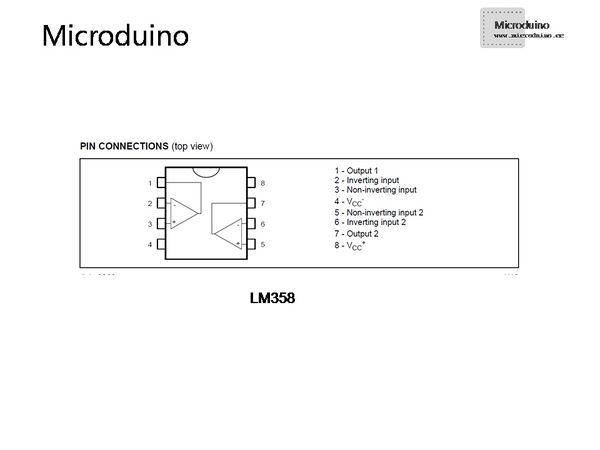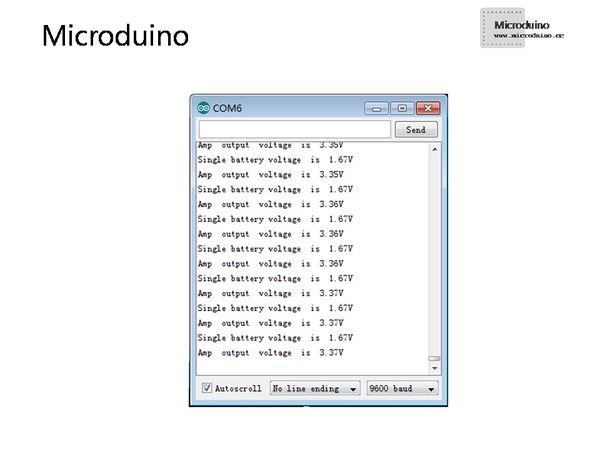Lesson 24--Microduino & Operational Amplifier--Noninverting Scaling Operation
Noninverting Scaling Operation Circuit Demo
Contents[hide]PurposeThe tutorial offers the basic knowledge of the operational amplifier. The example adopts the noninverting scaling operation circuit, which amplifies one dry cell battery to a certain ratio and detect the two voltage signals with Microduino. EquipmentMicroduino-Core is the 8-bit single-chip development core board with Atmel ATmega328P as the core, which is an open and Arduino Uno compatible controller. Microduino-USBTTL is the program download module, capable of connecting with Microduino-Core or Microduino-Core+ and making the modules communicate with the computer. It uses MicUSB as the download interface, which is also the smallest part of Microduino. Microduino is just as small as a quarter. Besides, the download cable is just like the USB cable of most smart phones, easy to use.
LM358 Operational AmplifierLM358 is a common chip, which contains two independent operation amplifier circuits inside. The operational amplifier A adopts pin 1 as the output end, pin 2 as the inverting output end and pin 3 as the noninverting input end. The operational amplifier B chooses pin 7 , pin 6 and pin 5 as the output end, inverting output end and noninverting input end respectively. The operational amplifier A and B share the same power end (Negative pin 4, positive pin 8). The chip can achieve both single and dual power supply, outputting the maximum voltage of 32V and +Vcc=+16V or -Vcc=-16V respectively. In the example, the negative of the battery connects with LM358 to the ground and the operational amplifier has single power supply for option. LM358文档下载: File:358pdf.pdf Dry BatteryThe dry battery is very common in our lives, whose electrolyte is non-liquid. That is why it gets the game. The dry battery can be supplied to the flashlight, radio, camera and electric toys. Here in the example is the AA battery. A cell of dry battery has a voltage of about 1.5 V, a cell of storage battery about 2V and the phone battery about 3.7V. SchematicThe output voltage of the LM358's pin 1 is Vout=Vin*(1+R2/R3). The noninverting scaling operation circuit owns high-input and low-output resistance. (High-input resistance means little influence on the signal source and low-output means strong load capacity.) Notably. No matter how we change the values of R2 and R3, the output voltage of the LM358's pin 1 won’t be higher than that of the power. (The voltage of the power in the example is 5V.) Program///A0 connect amp output
///A1 connect single battery output
int anaValueSingleBa; //single battery value map(0--1023)
int anaValueAmp; //amp value map(0--1023)
float anaVoltageSingleBa; //single battery voltage
float anaVoltageAmp; //amp output voltage
void setup()
{
Serial.begin(9600);
}
void loop()
{
anaValueSingleBa=analogRead(A1);
anaVoltageSingleBa=anaValueSingleBa/1023.0*5;
Serial.print("Single battery voltage is ");
Serial.print(anaVoltageSingleBa);
Serial.println("V");
delay(1000);
anaValueAmp=analogRead(A0);
anaVoltageAmp=anaValueAmp/1023.0*5;
Serial.print("Amp output voltage is ");
Serial.print(anaVoltageAmp);
Serial.println("V");
delay(1000);
}Debugging
ResultJust build the circuit according to the schematic After program download, you can watch the output voltage in the serial monitor of Arduino IDE. Contrast Formulae: Vout=Vin*(1+R2/R3) for ease of analyzing experimental data. Video |




